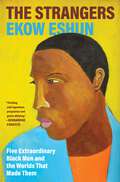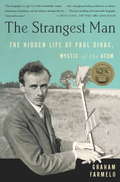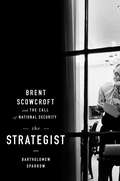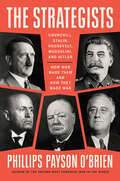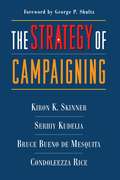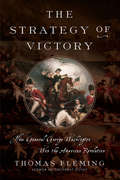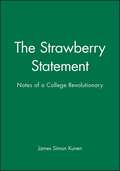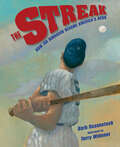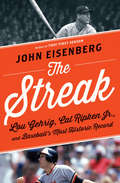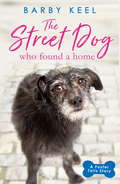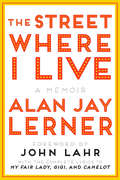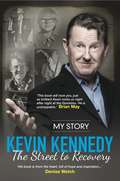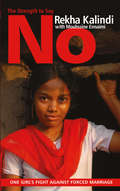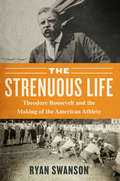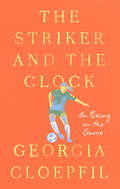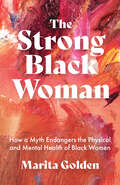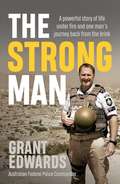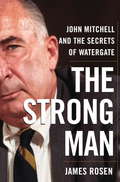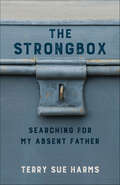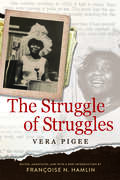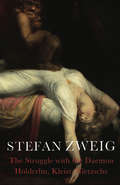- Table View
- List View
The Strangers: Five Extraordinary Black Men and the Worlds That Made Them
by Ekow Eshun“Moving, thoughtful, redemptive. The Strangers is an important book. It will become a Black classic.”— Ben Okri, author of The Famished Road“Thrilling and ingenious, propulsive and genre-defying: The Strangers is an outstanding book. Compelling and imaginatively expansive, this is something very special—creative nonfiction that inspires, stirs and challenges.”—Bernardine Evaristo, Booker Prize-winning author of Girl, Woman, OtherA richly imaginative, powerfully empathetic, and intimate portrait of five remarkable Black men that is also a moving meditation on race, estrangement, and the search for home.In the western imagination, a Black man is always a stranger, outsider, foreigner, intruder, alien; one who remains associated with their origins irrespective of how far they have travelled from them. One who is not an individual in his own right, but the representative of a type.What kind of performance is required for a person to survive this condition? What happens beneath the mask—what is the cost to the mind and body, to one’s relationships and one’s sense of self?Searching for answers, Ekow Eshun channels the voices of five very different individuals. Each man a renowned trailblazer in his field. Each man haunted by a sense of isolation and exile. Each man a stranger in his own world:Ira Aldridge, nineteenth century British actor and playwright;Matthew Henson, the first Black man to reach the North Pole;Frantz Fanon, French-Martinican psychiatrist and political philosopher;Malcolm X, civil rights activist and leader;Justin Fashanu, Britain’s first openly gay professional footballer.Telling their stories, Eshun pushes the boundaries of genre to capture them in all their complexity, interweaving biography, fiction, historical record, and memoir, sharing his own experiences living as a Black Briton in the art world. The Strangers illuminates both the hostility and the beauty each man encountered in the world, positioning them all within a wider landscape of Black art, culture, history, and politics throughout the diaspora.
The Strangest Man: The Hidden Life of Paul Dirac, Mystic of the Atom
by Graham FarmeloPaul Dirac was among the great scientific geniuses of the modern age. One of the discoverers of quantum mechanics, the most revolutionary theory of the past century, his contributions had a unique insight, eloquence, clarity, and mathematical power. His prediction of antimatter was one of the greatest triumphs in the history of physics. One of Einstein's most admired colleagues, Dirac was in 1933 the youngest theoretician ever to win the Nobel Prize in physics. Dirac's personality is legendary. He was an extraordinarily reserved loner, relentlessly literal-minded and appeared to have no empathy with most people. Yet he was a family man and was intensely loyal to his friends. His tastes in the arts ranged from Beethoven to Cher, from Rembrandt to Mickey Mouse. Based on previously undiscovered archives, The Strangest Man reveals the many facets of Dirac's brilliantly original mind. A compelling human story, The Strangest Man also depicts a spectacularly exciting era in scientific history.
The Strategist: Brent Scowcroft and the Call of National Security
by Bartholomew SparrowBased on the full cooperation of the subject--with no restraining conditions--The Strategist provides an in-depth portrait of a man whose career has been intimately linked to the great transformations in U. S. foreign policy, from the last third of the Cold War, to September 11, 2001, and up to the present. Bartholomew Sparrow brings color and focus to the complex and often secretive nature of U. S. foreign policy and strategic adjustments--an intellectual battlefield on which ideas and worldviews clash, in which economics, politics, and strategic concerns intertwine, and in which private citizens and non-office holders may exert as much influence as highly visible Cabinet officials. Among the most important foreign policy minds of the 20th and early 21st centuries, Brent Scowcroft is also among the least well-known or understood. In a now-famous August 2002 Wall Street Journal op-ed titled "Don’t Attack Saddam Hussein,” Brent Scowcroft, who had been national security advisor under President George H. W. Bush, went to war himself, in a sense, with his closest and longest-standing friends. He noted the scant evidence that tied the Iraqi government to terrorist organizations. He warned that an invasion and occupation of Iraq would be costly and potentially disastrous for a variety of carefully considered reasons. He recommended that the Bush administration work with the U. N. Security Council and wait for definitive proof of Saddam’s wrongdoing before taking action. The essay at once made Scowcroft the most outspoken and most credible critic of the Bush administration’s plans for war and immediately generated national controversy. It provoked a sudden, deep split in the Republican Party over the plans for war. Vice President Cheney, National Security Advisor Rice, Defense Secretary Rumsfeld, and President George W. Bush all vigorously reaffirmed their cause and their course of action, and the media and American public opinion soon fell in line. Clearly, Scowcroft, 84, continues to participate in the most central and important debates over U. S. foreign policy and national security. He has been a leading architect of U. S. foreign policy and grand strategy for almost a half-century, and though long out of office, still gives speeches, makes media appearances, and leads tasks forces and commissions. He is a rare creature, one of the few "wise men” of the nation’s capital: someone who is regularly consulted by top government officials in Democratic and Republican administrations, ranking members of the House and Senate from both sides of the aisle, and the country’s leading foreign-policy journalists. As recently as April 2009, Scowcroft co-chaired an extensive Council of Foreign Relations study of the U. S. nuclear weapons policy. More than anyone else, he stands at the center of the United States’ foreign policy establishment. Most significantly, Scowcroft is trusted--a scarce and typically fleeting quality in Washington--and has been for four decades. The unprecedented insights into the man and his career Sparrow offers in The Strategist are vital to anyone who wishes to understand America's changing role in the world.
The Strategists: Churchill, Stalin, Roosevelt, Mussolini, and Hitler--How War Made Them and How They Made War
by Phillips Payson O'BrienChurchill. Hitler. Stalin. Mussolini. Roosevelt. Five of the most impactful leaders of WW2, each with their own individualistic and idiosyncratic approach to warfare. But if we want to understand their military strategy, we must first understand the strategist.In The Strategists, Professor Phillips Payson O'Brien shows how the views these five leaders forged in WW1 are crucial to understanding how they fought WW2. For example, Churchill's experiences of facing the German Army in France in 1916 made him unwilling to send masses of British soldiers back there in the 1940s, while Hitler's mistakes on the Eastern Front were influenced by his reluctance to accept that conditions had changed since his own time fighting. The implications of the power of leaders remain with us to this day: to truly understand what is happening in Ukraine, for example, requires us to know what has influenced the leaders involved.This is a history in which leaders—and their choices—matter. For better or worse.
The Strategy of Campaigning: Lessons from Ronald Reagan and Boris Yeltsin
by Bruce Bueno de Mesquita Kiron K. Skinner Condoleezza Rice Serhiy KudeliaThe Strategy of Campaigningexplores the political careers of Ronald Reagan and Boris Yeltsin, two of the most galvanizing and often controversial political figures of our time. Both men overcame defeat early in their political careers and rose to the highest elected offices in their respective countries. The authors demonstrate how and why Reagan and Yeltsin succeeded in their political aspirations, despite-or perhaps because of-their apparent "policy extremism": that is, their advocacy of policy positions far from the mainstream. The book analyzes the viability of policy extremism as a political strategy that enables candidates to forge new coalitions and outflank conventional political allegiances. Kiron K. Skinner is Associate Professor of International Relations and Political Science at Carnegie Mellon University, a Research Fellow at the Hoover Institution, and a member of the Chief of Naval Operations Executive Panel and the National Security Education Board. Serhiy Kudelia is Lecturer of Politics at Kyiv-Mohyla Academy, Ukraine and advisor to Deputy Prime Minister of Ukraine. Bruce Bueno de Mesquita is Julius Silver Professor and Director of the Alexander Hamilton Center for Political Economy at New York University and a Senior Fellow at the Hoover Institution. Condoleezza Rice is on a leave of absence from Stanford University, where she was a Professor of Political Science and a Senior Fellow at the Hoover Institution. She is currently serving as U. S. Secretary of State.
The Strategy of Victory: How General George Washington Won the American Revolution
by Thomas FlemingA sweeping and insightful grand strategic overview of the American Revolution, highlighting Washington's role in orchestrating victory and creating the US ArmyLed by the Continental Congress, the Americans almost lost the war for independence because their military thinking was badly muddled. Following the victory in 1775 at Bunker Hill, patriot leaders were convinced that the key to victory was the home-grown militia--local men defending their families and homes. But the flush of early victory soon turned into a bitter reality as the British routed Americans fleeing New York.General George Washington knew that having and maintaining an army of professional soldiers was the only way to win independence. As he fought bitterly with the leaders in Congress over the creation of a regular army, he patiently waited until his new army was ready for pitched battle. His first opportunity came late in 1776, following his surprise crossing of the Delaware River. In New Jersey, the strategy of victory was about to unfold.In The Strategy of Victory, preeminent historian Thomas Fleming examines the battles that created American independence, revealing how the creation of a professional army worked on the battlefield to secure victory, independence, and a lasting peace for the young nation.
The Strawberry Statement
by James S. KunenWriting from the vantage point of a priveleged middleclass student attending columbia University during the Vietnam War in the 1960's, the author is transformed from a "conformist" "Jock" into a politically and Socially Radical "Puke". He also experiences his first Romance, finds that changes is harder to accomplish than idealism might indicate, and rarely pure... He also reflects upon his writing and experiences with 40 years of life behind the point where he authored the book...
The Stray Bullet: William S. Burroughs in Mexico
by Jorge García-RoblesWilliam S. Burroughs arrived in Mexico City in 1949, having slipped out of New Orleans while awaiting trial on drug and weapons charges that would almost certainly have resulted in a lengthy prison sentence. Still uncertain about being a writer, he had left behind a series of failed business ventures—including a scheme to grow marijuana in Texas and sell it in New York—and an already long history of drug use and arrests. He would remain in Mexico for three years, a period that culminated in the defining incident of his life: Burroughs shot his common-law wife, Joan Vollmer, while playing William Tell with a loaded pistol. (He would be tried and convicted of murder in absentia after fleeing Mexico.)First published in 1995 in Mexico, where it received the Malcolm Lowry literary essay award, The Stray Bullet is an imaginative and riveting account of Burroughs&’s formative experiences in Mexico, his fascination with Mexico City&’s demimonde, his acquaintances and friendships there, and his contradictory attitudes toward the country and its culture. Mexico, Jorge García-Robles makes clear, was the place in which Burroughs embarked on his &“fatal vocation as a writer.&”Through meticulous research and interviews with those who knew Burroughs and his circle in Mexico City, García-Robles brilliantly portrays a time in Burroughs&’s life that has been overshadowed by the tragedy of Joan Vollmer&’s death. He re-creates the bohemian Roma neighborhood where Burroughs resided with Joan and their children, the streets of postwar Mexico City that Burroughs explored, and such infamous figures as Lola la Chata, queen of the city&’s drug trade. This compelling book also offers a contribution by Burroughs himself—an evocative sketch of his shady Mexican attorney, Bernabé Jurado.
The Streak: How Joe DiMaggio Became America's Hero
by Terry Widener Barb RosenstockIn the summer of 1941, Yankee center fielder Joe DiMaggio and his favorite bat, Betsy Ann, begin the longest hitting streak in baseball history. But when Betsy Ann goes missing, will DiMaggio keep hitting? Set on the brink of World War II, this is a spellbinding account of a sports story that united the country and made DiMaggio a hero, at a time when one was profoundly needed. Barb Rosenstock's action-packed text and Terry Widener's powerful illustrations capture DiMaggio's drive as well as his frustration. The book also includes headlines, quotes, stats, and a detailed bibliography.
The Streak: Lou Gehrig, Cal Ripken Jr., and Baseball's Most Historic Record
by John Eisenberg&“A line-drive hit of a book&” about the Iron Horse and the Iron Man—two legends from two eras of baseball—and the nature of human endurance (The Wall Street Journal).When Cal Ripken Jr. began his career with the Baltimore Orioles at age twenty-one, he had no idea he would someday beat the historic record of playing 2,130 games in a row, a record set forty-two years before by the fabled &“Iron Horse&” of the New York Yankees, Lou Gehrig. Ripken went on to surpass that record by 502 games, and the baseball world was floored. Few feats in sports history have generated more acclaim. But the record spawns an array of questions. When did someone first think it was a good idea to play in so many games without taking a day off? Who owned the record before Gehrig? Whose streak—Gehrig&’s or Ripken&’s—was the more difficult achievement? Through probing research, meticulous analysis, and colorful parallel storytelling, The Streak delves into this impressive but controversial milestone, unraveling Gehrig&’s at-times unwitting pursuit of that goal (Babe Ruth used to think Gehrig crazy for wanting to play every game), and Ripken&’s fierce determination to stay in the lineup and continue to contribute whatever he could even as his skills diminished with age. So many factors contribute to the comparisons between the two men: the length of seasons, the number of teams in the major leagues, the inclusion of nonwhite players, travel, technology, medical advances, and even media are all part of the equation. This is a book that captures the deeply American appreciation—as seen in the sport itself—for a workaday mentality and that desire to be there for the game every time it called.&“It tackles the allure of human endurance and the pitfalls of fame, but it is mostly a baseball book for baseball fans. It succeeds as both a thorough accounting and a love note to the game.&”—The Washington Post
The Street Dog Who Found a Home
by Barby KeelA heartwarming true animal story, for fans of A Dog's Purpose, A Street Cat Named Bob and Marley & Me.When Chewy the dog arrives at the animal sanctuary run by the inimitable Barby Keel, the scrawny little dog is terrified. Having been abandoned by his beloved owner, who is himself homeless, Chewy's whole world has been turned upside down. After years of sleeping on the streets, Chewy knows what it is to be cold and hungry, to have nowhere safe to stay, no warm bed to sleep on, no regular food or time to play. Despite her resolve to not get too attached to the animals that come into her care, Barby cannot help but feel there is something special about this little dog. Soon he won't let Barby out of his sight, and in doing so works his way into her heart. But some scars run too deep and it takes every ounce of Barby's patience to help Chewy heal from the traumas of his past. In doing so, Barby learns that in healing others, we often heal ourselves. A Street Cat Named Bob meets Marley & Me, The Street Dog Who Found a Home is a beautifully uplifting and heartwarming tale of the love and friendship that exists between humans and animals.
The Street Dog Who Found a Home (A Foster Tails Story)
by Barby KeelA heartwarming true animal story, for fans of A Dog's Purpose, A Street Cat Named Bob and Marley & Me. When Chewy the dog arrives at the animal sanctuary run by the inimitable Barby Keel, the scrawny little dog is terrified. Having been abandoned by his beloved owner, who is himself homeless, Chewy's whole world has been turned upside down. After years of sleeping on the streets, Chewy knows what it is to be cold and hungry, to have nowhere safe to stay, no warm bed to sleep on, no regular food or time to play. Despite her resolve to not get too attached to the animals that come into her care, Barby cannot help but feel there is something special about this little dog. Soon he won't let Barby out of his sight, and in doing so works his way into her heart. But some scars run too deep and it takes every ounce of Barby's patience to help Chewy heal from the traumas of his past. In doing so, Barby learns that in healing others, we often heal ourselves. A Street Cat Named Bob meets Marley & Me, The Street Dog Who Found a Home is a beautifully uplifting and heartwarming tale of the love and friendship that exists between humans and animals.
The Street Where I Live: A Memoir (Pop Concert Full Orchestra Ser.)
by Alan J. Lerner“Lerner will always be remembered as a Broadway light, and one of the brightest.” —Tom Shales, The Washington Post The Street Where I Live is at once an intimate biography of three great shows—My Fair Lady, Gigi, and Camelot—and a candid account of the life and times of Alan J. Lerner, one of America’s most acclaimed and popular lyricists. Large-hearted, humorous, and often poignant in its reverence for a celebrated era in the American theater, this is the story of what Lerner calls "the sundown of wit, eccentricity, and glamour." Try as he might to keep himself out of these pages, Lerner reveals himself to be a man of great talent, laughter, and love. Along the way, we meet a sensational supporting cast: Moss Hart, Fritz Loewe, Julie Andrews, Richard Burton, Rex Harrison, Cecil Beaton, Louis Jourdan, and Maurice Chevalier, to name a few. They are seen in moments of triumph and disaster, but all are professionals at the creation of theater. And the creation of theater is the matrix of this wonderful book. Included are the complete lyrics to My Fair Lady, Gigi, and Camelot.
The Street to Recovery
by Kevin KennedyCurly Watts is a TV icon - for twenty years appearing on millions of TV screens around the country in Coronation Street. Kevin Kennedy is one of the UK's most successful soap actors, although behind the scenes and high-profile appearances, he faced a painful personal battle.Kevin shares his experiences of alcoholism, rehab and IVF as well stories from the set and stars he worked with during some of the brightest, and darkest moments of his life, through to his music career and current roles.This brutally honest autobiography provides a rare glimpse into life behind the scenes, the power of addiction, and his battle with recovery.
The Strength of Hope: A Holocaust Survivor's Guide to Love and Life
by Fiona Harris Abram GoldbergOne of the most uplifting stories you will ever read. Abram Goldberg is a beacon of joy and optimism, and a master of keeping perspective.The day Abram and his mother arrived at Auschwitz death camp they both knew it would be her last. In their final moment together, Abram's mum urged her nineteen-year-old son to 'do everything humanly possible to survive, and tell people what happened here'. Then she was taken to a gas chamber and murdered. Abram had already endured and survived so much until that moment, but with his strength of hope, sometimes reduced to a flicker, he survived.After liberation, Abram eventually found his way to Belgium, where he met the love of his life, fellow Auschwitz survivor Cesia. The young couple came to Australia, where that flicker of hope grew as bright as the sun, illuminating everything they touched and everyone who came into their sphere. Without bitterness and always with perspective, Abram has never forgotten his mother's last words to him. And in their seventy-five years of marriage, Abram and Cesia have remained dedicated to educating people about the Holocaust and to living their lives to the fullest in tribute to its victims.
The Strength of Hope: A Holocaust Survivor's Guide to Love and Life
by Abram Goldberg HarrisOne of the most uplifting stories you will ever read. Abram Goldberg is a beacon of joy and optimism, and a master of keeping perspective.The day Abram and his mother arrived at Auschwitz death camp they both knew it would be her last. In their final moment together, Abram's mum urged her nineteen-year-old son to 'do everything humanly possible to survive, and tell people what happened here'. Then she was taken to a gas chamber and murdered. Abram had already endured and survived so much until that moment, but with his strength of hope, sometimes reduced to a flicker, he survived.After liberation, Abram eventually found his way to Belgium, where he met the love of his life, fellow Auschwitz survivor Cesia. The young couple came to Australia, where that flicker of hope grew as bright as the sun, illuminating everything they touched and everyone who came into their sphere. Without bitterness and always with perspective, Abram has never forgotten his mother's last words to him. And in their seventy-five years of marriage, Abram and Cesia have remained dedicated to educating people about the Holocaust and to living their lives to the fullest in tribute to its victims.
The Strength to Say No
by Mouhssine Ennaimi Rekha KalindiThe true story of one girl who said "no" to tradition, and the effect it had upon a nationIn a remote village in Bengal, 11-year-old Rekha and her large family lived by rolling handmade cigarettes. She frequently observed the abrupt departure of her friends to go live with their mothers-in-law, where they were often treated like slaves. In spite of her youth, Rekha was aware of the harm done to these little girls. When, in their turn, her parents found a husband for her, a man she didn't know, she flew into a blinding rage at the idea of being taken away from any further schooling for good. After that, Rekha went from village to village to tell her story, and especially to explain the tragic consequences of early marriages. Thanks to her, several dozen children found the courage to say no to this tribal tradition. Her story gained national attention with India's newspaper hailing her for accomplishing change that the India government was incapable of making. Her exemplary journey gained her the recognition of the highest courts in the land, she has had an audience with the Indian President, and she is a recipient of India's National Bravery Award. Written with the collaboration of Mouhssine Ennaimi, a distinguished reporter for Radio France, The Strength to Say No, translated from Ennaimi's acclaimed French edition, is a documentary portrait of one girl's monumental struggle.
The Strenuous Life: Theodore Roosevelt and the Making of the American Athlete
by Ryan Swanson&“It seemed as if Theodore Roosevelt&’s biographers had closed the book on his life story. But Ryan Swanson has uncovered an untold chapter&” (Johnny Smith, coauthor of Blood Brothers: The Fatal Friendship between Muhammad Ali and Malcolm X). Crippling asthma, a frail build, and grossly myopic eyesight: these were the ailments that plagued Teddy Roosevelt as a child. In adulthood, he was diagnosed with a potentially fatal heart condition and was told never to exert himself again. Roosevelt&’s body was his weakness, the one hill he could never fully conquer—and as a result he developed what would become a lifelong obsession with athletics that he carried with him into his presidency. As President of the United States, Roosevelt boxed, practiced Ju-Jitsu, played tennis nearly every day, and frequently invited athletes and teams to the White House. It was during his administration that America saw baseball&’s first ever World Series; interscholastic sports began; and schools began to place an emphasis on physical education. In addition, the NCAA formed, and the United States hosted the Olympic Games for the first time. From a prize-winning historian, this book shows how Roosevelt fought desperately (and sometimes successfully) to shape American athletics in accordance with his imperialistic view of the world. It reveals that, in one way or another, we can trace our fanaticism for fitness and sports directly back to the twenty-sixth president and his relentless pursuit of &“The Strenuous Life.&” &“Essential reading for anyone who cares about the history of sports in America.&” —Michael Kazin, author of War against War: The American Fight for Peace, 1914–1918
The Striker and the Clock: On Being in the Game
by Georgia CloepfilAn illuminating perspective on the life of an athlete and the pursuit of excellence outside the spotlight.Georgia Cloepfil played professional soccer for six years, on six teams, in six countries. In those years, the sport became more than a game—it was an immersive yet transient way of life. In South Korea, she lived and practiced in an isolated island compound next to an airport. In Australia, she coached youth teams on the side to pay her rent. In Lithuania, she played in the European Champions League, to empty stadiums and little fanfare. She lived out of a single suitcase, chasing better opportunities and the euphoria of playing well. The Striker and the Clock is a beautiful examination of the joy and pain of serious athletics. It&’s also an eye-opening look at the still-developing world of professional women&’s soccer. Written in ninety short passages—reflecting the ninety inexorably passing minutes of a soccer match—the book is a love letter to a maddening sport and a reflection on the way it has shaped a life. In vivid prose, it portrays the athlete as an artist, debating how much of herself to devote to her craft. This finely wrought, singular book celebrates the complex appeal of sports and the fulfillment found in fleeting moments of glory.
The Strong Black Woman: How a Myth Endangers the Physical and Mental Health of Black Women
by Marita GoldenMajor Health Crisis Among Black Women Generated from Systemic Racism “Marita Golden’s The Strong Black Woman busts the myth that Black women are fierce and resilient by letting the reader in under the mask that proclaims ‘Black don’t crack.’” ―Karen Arrington, coach, mentor, philanthropist, and author of NAACP Image Award-winning Your Next Level LifeSarton Women’s Book Award#1 New Release in ReferenceMeet Black women who have learned through hard lessons the importance of self-care and how to break through the cultural and family resistance to seeking therapy and professional mental health care.The Strong Black Woman Syndrome. For generations, in response to systemic racism, Black women and African American culture created the persona of the Strong Black Woman, a woman who, motivated by service and sacrifice, handles, manages, and overcomes any problem, any obstacle. The syndrome calls on Black women to be the problem-solvers and chief caretakers for everyone in their lives―never buckling, never feeling vulnerable, and never bothering with their pain.Hidden mental health crisis of anxiety and depression. To be a Black woman in America is to know you cannot protect your children or guarantee their safety, your value is consistently questioned, and even being “twice as good” is often not good enough. Consequently, Black women disproportionately experience anxiety and depression. Studies now conclusively connect racism and mental health―and physical health.Take care of your emotional health. You deserve to be emotionally healthy for yourself and those you love. More and more young Black women are re-examining the Strong Black Woman syndrome and engaging in self-care practices that change their lives.Hear stories of Black women who:Asked for helpBuilt lives that offer healingLearned to accept healingIf you have read The Unapologetic Guide to Black Mental Health, The Racial Healing Handbook, or Black Fatigue, The Strong Black Woman is your next read.
The Strong Man: A powerful story of life under fire and one man's journey back from the brink
by Grant EdwardsA powerful story of life under fire and one man's journey back from the brink Grant Edwards was once an elite athlete, Olympics qualifier and Australia’s strongest man. His Guinness Book of Records feats of strength were acclaimed internationally, and as a high ranking police officer he spent decades protecting vulnerable people around the world. But nothing could shield him from catastrophic harm in the line of duty. Rising above his tough beginnings in 1970s suburbia, where he was bullied for his father’s decision to live as a gay man, Edwards found sanctuary in sport. But he found his true calling with the Australian Federal Police, rising swiftly through the ranks to Commander and personally establishing cybercrime units to fight child exploitation and human trafficking. A highly sought after and disciplined security advisor for governments around the world such as East Timor, Afghanistan and the Americas, Edwards was considered the last person to ‘crack’ – but a narrow escape from a deadly attack in Kabul pushed him to breaking point. This is the story of an extraordinary man and his extraordinary battle back from the brink.
The Strong Man: John Mitchell and the Secrets of Watergate
by James RosenRosen (a Washington correspondent for Fox News) presents a biography of Richard Nixon's Attorney General John Mitchell, whose conviction in the Watergate cover-up trial provided the dubious honor of being the highest-ranking US government official to have to serve time in prison. Rosen addresses a host of previously unanswered questions, including whether Mitchell ordered the Watergate break-in, Mitchell's role in the SEC case against fugitive financier Robert Vesco, the role of the Central Intelligence Agency in Watergate, the response of Mitchell to the discovery that the Joint Chiefs of Staff were spying on Nixon and Henry Kissinger, Mitchell's activities concerning school desegregation and antitrust laws, and Mitchell's response to Kent State. Also covered is Mitchell's involvement in cases concerning Daniel Ellsberg, Lt. William Calley, Jimmy Hoffa, Robert Vesco, Abe Fortas, Clement Haynsworth, John Lennon, the Berrigan Brothers, the Black Panthers, and ITT. In the end, Mitchell is portrayed as a man who repeatedly served as a restraining influence on the darker urges of Richard Nixon and as a victim of many unfair charges concerning the Watergate affair, although some unpunished crimes are also noted, such as his illegal intervention with South Vietnamese officials at the 1968 Paris peace talks, his false testimony before the Senate concerning the ITT case, and his false statements to the FBI agents investigating the 1969-71 Kissinger wiretaps. Annotation ©2008 Book News, Inc. , Portland, OR (booknews. com)
The Strongbox: Searching for My Absent Father
by Terry Sue HarmsFollowing the unexpected death of her alcoholic mother, and worn down by the unceasing taunts of “bastard” from her hostile and mentally unstable stepfather, plucky sixteen-year-old Terry Sue sets out to find her biological father—believing this man, whom she has never met, could change her life for the better. But before she can find him, she must identify him, and the unfamiliar names on her birth certificate perplex her. She comes to realize that tenacity must run in her family, for as determined as she is to find her father, he appears equally determined to remain hidden. In The Strongbox, Terry Sue offers readers a forthright and inspirational account of her challenges, as well as her against-all-odds successes. This decades-long personal journey reads like a detective novel, full of setbacks, false leads, jaw-dropping discoveries, and heartening triumphs. The narrative’s twists and turns also pull back the curtain on many of today’s inconvenient truths: child abandonment, multigenerational alcoholism, sexism, economic inequality, domestic violence, mental illness, and illiteracy. Undaunted by the many blind alleys she encounters, Terry Sue forges on in her hunt for the loving care and emotional support she never received from her parents, and she ultimately finds it—but it arrives in forms she never expected.
The Struggle of Struggles (Civil Rights in Mississippi Series)
by Vera PigeeNamed one of five best books on women in the Civil Rights Movement by Wall Street JournalFrom 1955 to 1975, Vera Pigee (1924–2007) put her life and livelihood on the line with grassroots efforts for social change in Mississippi, principally through her years of leadership in Coahoma County’s NAACP. Known as the “Lady of Hats,” coined by NAACP executive secretary Roy Wilkins, Pigee was a businesswoman, mother, and leader. Her book, The Struggle of Struggles, offers a detailed view of the daily grind of organizing for years to open the state’s closed society. Fearless, forthright, and fashionable, Pigee also suffered for her efforts at the hands of white supremacists and those unwilling to accept strong women in leadership. She wrote herself into the histories, confronted misinformation, and self-published one of the first autobiographies from the era. Women like her worked, often without accolade or recognition, in their communities all over the country, but did not document their efforts in this way.The Struggle of Struggles, originally published in 1975, spotlights the gendered and generational tensions within the civil rights movement. It outlines the complexity, frustrations, and snubs, as well as the joy and triumphs that Pigee experienced and witnessed in the quest for a fairer and more equitable nation. This new edition begins with a detailed introductory essay by historian Françoise N. Hamlin, who interviewed Pigee and her daughter in the few years preceding their passing, as well as their coworkers and current activists. In addition to the insightful Introduction, Hamlin has also provided annotations to the original text for clarity and explanation, along with a timeline to guide a new generation of readers.
The Struggle with the Daemon
by Eden Paul Cedar Paul Stefan ZweigThe Struggle with the Daemon is a brilliant analysis of the European psyche by the great novelist and biographer Stefan Zweig. Zweig studies three giants of German literature and thought: Friedrich Ho¨lderlin, Heinrich von Kleist and Friedrich Nietzsche - powerful minds whose ideas were at odds with the scientific positivism of their age; troubled spirits whose intoxicating passions drove them mad but inspired them to great works. In their struggle with their inner creative force, Zweig reflects the conflict at the heart of the European soul - between science and art, reason and inspiration.Both highly personal and philosophically wide-ranging, this is one of the most fascinating of Zweig's renowned biographical studies.From the Trade Paperback edition.
